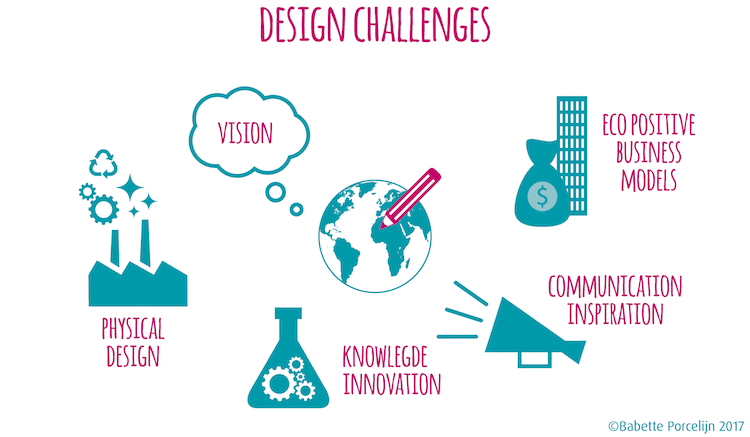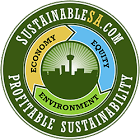Designer Talks About Eco Positive Environmental Impact
Elegant design and engineering goes beyond being sustainable to being eco positive. New vocabulary, additional data collection and working with scientists is needed to most effectively stimulate and manage a circular economy, making the means by which we live to be resilient, efficient and productive, and most of all, regenerative and eco positive.
Did you know that most average Americans live as though they have 4.8 planets? This is what Dutch industrial designer Babette Porcelijn discovered when she largely left behind a thriving business working with commercial clients to focus on the hidden impacts of design.
In her research, Porcelijn looks at everything from the global impact of importing and exporting to the environmental toll of producing single consumer items, such as a laptop computer. Her “Impact Top 10” breaks down, with surprising results, the average items used by consumers that cause the largest amount of environmental impact.
Who knew that meat would come in second, beat out only by consumer products, but well above cars? (If you speak Dutch and want to understand your individual impact, answer a few questions to see how you compare to others.)
Excerpts from the interview:
- The sixteen largest container ships emit as much sulfur as all the cars in the world together
- The rich consumer buys a lot of products, but he does not see the impact the production of these goods has on the environment. How can you make sustainable choices if you don't know what’s going on?
- When I started to investigate, I was shocked to find out that often I couldn’t find answers to my questions. Even worse, sometimes there were no words to describe the things I wanted to talk about. The worst finding, perhaps, was the fact that there was no impact top 10 of the average consumer, including hidden impacts.
- If we assess the impact of the consumer, we usually only consider environmental impacts caused by the use of a product. Furthermore, we mainly look at climate effects, but if we solve the climate problem, and we don’t solve problems like water scarcity, pollution or plastic soup, then we still have a problem.
- Over the last few decades, rich consumer countries have moved much of their industry and agriculture to low-wage countries. Production comes with lots of impact on climate, nature, and environment. Rich countries import these products and this food and their consumers buy these. But we often leave the “hidden impact” out of the equation.
- Designers can make a big difference in many ways. First, we are beginning to understand what we should NOT do anymore—and Hidden Impact reveals that thoroughly—but the next question is, what to replace the fulfillment of our needs in a sustainable way? What SHOULD we do? And that is a design challenge! I think we need to work together with scientists to come up with the best solutions.
- We are trained systems thinkers, and the world needs those—product designers can design circular products, and circular business models, while product designers and architects can design for long endurance products, with renewable materials and design for disassembly and reuse.
- We could take responsibility for the products we put in the world; do we want to add more stuff people don’t really need into the world, while it damages the environment and brings our joint future in jeopardy, while the ones who benefit have commercial motives instead of humane motives? Also, design for communication: tell the world what’s at stake and what we can do about it, inspire them with awesome alternatives which are more attractive than our current ways
- In short, we need nothing short of a paradigm shift and we need designers to make it a good one. Eco-positive* and fair.

- The best thing that can happen—and it does, people tell me—is that people actually change their lifestyles. I will never tell people what they should or shouldn’t do. I merely help those who want to make effective changes to improve their environmental impact. And I hope to inspire people as a side-effect of my research.
- Some of the biggest issues you mention, like microplastics, come from items like car tires. With this being such a common item, do you know of any companies working on alternative solutions? ANSWER: It is a common item, but it isn’t common knowledge yet. Nevertheless, I’ve heard about research for better tire materials, but that’s difficult to tackle since biodegradable plastics in nature aren’t as biodegradable as in the lab. We could catch run-off from the roads and clean it, and we could choose a different means of transportation (bike, walk, and public transit).
- We need as many people on board as possible. Especially in rich consumer countries, which have—on average—the biggest impact. In the twelve biggest economies in the world lives 13% of the world population, but we cause 55% of the impact! That means that with 13% of the people, we can reduce over half the impact, and that’s a hopeful thought to me.

- We, consumers, are key. Ultimately, we decide everything that’s going on in the world, even though we often don’t realize it. We buy products and with our money, companies thrive. They can either damage or save the environment, and we get to choose which ones survive by buying their stuff. We decide who our politicians are and what they will fight for. The more money you have, the more difference you can make, either by your lifestyle and daily habits or by devoting yourself as a professional to for an eco-positive society*.
[*Eco positive: when you (or a company, or a city/country etc) have a more positive impact on the environment than negative, harmful impact. Protecting and restoring nature, working on family planning and reducing population growth, designing sustainable or eco-positive solutions, cleaning up pollution etc.]
Read more about Porcelijn, her work and how she hopes her book can help create change both for consumers and designers in the full interview.
Source: Interview with Designer Babette Porcelijn About Environmental Impact


Sustainable development is built on economic development, environmental protection, and social change. Let's make this happen!
Thank you Keith and excellent point! And I agree, let’s make this happen! Please sign up for our newsletter and spread the word to others. Thanks again, talk with you soon and look forward to making it happened together.